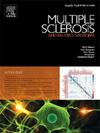Effect of siponimod on retinal thickness, a marker of neurodegeneration, in participants with SPMS: Findings from the EXPAND OCT substudy
IF 2.9
3区 医学
Q2 CLINICAL NEUROLOGY
引用次数: 0
Abstract
Background
People with MS show abnormal thinning of the retinal layers, which is associated with clinical disability and brain atrophy, and is a potential surrogate marker of neurodegeneration and treatment effects.
Objective
To evaluate the utility of retinal thickness as a surrogate marker of neurodegeneration and treatment effect in participants with secondary progressive MS (SPMS) from the optical coherence tomography (OCT) substudy of the EXPAND Phase 3 clinical trial (siponimod versus placebo).
Methods
In the OCT substudy population (n = 159), treatment effects on change in the average thickness of the retinal layer, peripapillary retinal nerve fiber layer (pRNFL), and combined macular ganglion cell and inner plexiform layers (GCIPL) were analyzed by high-definition spectral domain OCT at months 3, 12, and 24.
Results
Thinning from baseline was observed across all retinal layers and time points in the placebo group. Siponimod significantly reduced GCIPL thinning versus placebo at month 24 (adjusted mean [SE] [µm]: −0.47 [0.81] vs. −4.29 [1.23]; p = 0.01), and overall retinal thinning at months 12 (+0.66 [0.54] vs. −1.86 [0.75]; p = 0.006) and 24 (−0.05 [0.59] vs. −2.30 [0.88]; p = 0.033). Although not significant, results for pRNFL consistently followed the same trends.
Conclusion
This exploratory substudy supports further investigation of OCT measurement of retinal atrophy as a non-invasive potential biomarker of treatment effects on neurodegeneration in SPMS.
求助全文
约1分钟内获得全文
求助全文
来源期刊

Multiple sclerosis and related disorders
CLINICAL NEUROLOGY-
CiteScore
5.80
自引率
20.00%
发文量
814
审稿时长
66 days
期刊介绍:
Multiple Sclerosis is an area of ever expanding research and escalating publications. Multiple Sclerosis and Related Disorders is a wide ranging international journal supported by key researchers from all neuroscience domains that focus on MS and associated disease of the central nervous system. The primary aim of this new journal is the rapid publication of high quality original research in the field. Important secondary aims will be timely updates and editorials on important scientific and clinical care advances, controversies in the field, and invited opinion articles from current thought leaders on topical issues. One section of the journal will focus on teaching, written to enhance the practice of community and academic neurologists involved in the care of MS patients. Summaries of key articles written for a lay audience will be provided as an on-line resource.
A team of four chief editors is supported by leading section editors who will commission and appraise original and review articles concerning: clinical neurology, neuroimaging, neuropathology, neuroepidemiology, therapeutics, genetics / transcriptomics, experimental models, neuroimmunology, biomarkers, neuropsychology, neurorehabilitation, measurement scales, teaching, neuroethics and lay communication.
 求助内容:
求助内容: 应助结果提醒方式:
应助结果提醒方式:


